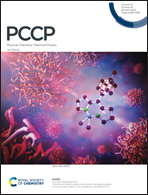Chlorination versus hydroxylation selectivity mediated by the non-heme iron halogenase WelO5†
Abstract
The selectivity of halogenation versus hydroxylation in α-KG de-pendent halogenases is vital to their function and has been widely studied, particularly using the halogenase SyrB2 as a model. WelO5, a new member of α-KG dependent halogenases, catalyzes the chlorination of 12-epi-fischerindole U in the welwitindolinone biosynthetic pathway. Herein, we give a detailed insight into the selectivity of WelO5 through combined quantum mechanical/molecular mechanical (QM/MM) calculations for the whole catalytic cycle. O2 activation leads to a Fe(IV)![[double bond, length as m-dash]](https://www.rsc.org/images/entities/char_e001.gif) O moiety which adopts an equatorial conformation (in the plane consisting of His164, chloride and Fe atom), in contrast to axial conformation (perpendicular to the plane). Key to the conformational selectivity is a serine residue (Ser189) in the equatorial plane, that brings the precursor of the Fe(IV)
O moiety which adopts an equatorial conformation (in the plane consisting of His164, chloride and Fe atom), in contrast to axial conformation (perpendicular to the plane). Key to the conformational selectivity is a serine residue (Ser189) in the equatorial plane, that brings the precursor of the Fe(IV)![[double bond, length as m-dash]](https://www.rsc.org/images/entities/char_e001.gif) O intermediate (a Fe(II)–peracid complex) to the equatorial conformation through hydrogen bonding. Hydrogen abstraction of the substrate by the equatorial Fe(IV)
O intermediate (a Fe(II)–peracid complex) to the equatorial conformation through hydrogen bonding. Hydrogen abstraction of the substrate by the equatorial Fe(IV)![[double bond, length as m-dash]](https://www.rsc.org/images/entities/char_e001.gif) O leads to a five-coordinated HO–Fe(III)–Cl complex, where the hydroxyl ligand is still equatorial and thus relatively far from the substrate radical in the axial direction compared to the chloride ligand. This smoothly explains the extremely high selectivity of chlorination in WelO5 and provides a microscopic explanation for the experimental finding that S189A WelO5 ceases to display any chlorination selectivity versus hydroxylation. Notably, although Ser189 is vital for the selectivity of the enzyme, it is not part of the substrate binding pocket. Therefore, WelO5 serves as an excellent example how chemoselectivity can be achieved in directed evolution without the tedious redesign of the substrate binding pocket.
O leads to a five-coordinated HO–Fe(III)–Cl complex, where the hydroxyl ligand is still equatorial and thus relatively far from the substrate radical in the axial direction compared to the chloride ligand. This smoothly explains the extremely high selectivity of chlorination in WelO5 and provides a microscopic explanation for the experimental finding that S189A WelO5 ceases to display any chlorination selectivity versus hydroxylation. Notably, although Ser189 is vital for the selectivity of the enzyme, it is not part of the substrate binding pocket. Therefore, WelO5 serves as an excellent example how chemoselectivity can be achieved in directed evolution without the tedious redesign of the substrate binding pocket.



 Please wait while we load your content...
Please wait while we load your content...